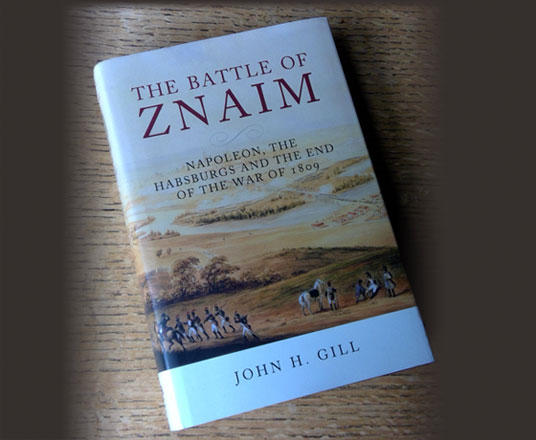

As lockdown maintained its grip on everyday life, 2020
coursed its way from Spring into Summer in a manner never
experienced before. But at least there was some good news for
the 1809 project. Greenhill Books were publishing a new
John Gill book in August! Of course, the Napoleon of this
project had the book ordered well in advance – as a well-
timed birthday present. (Yes, an August baby like the French
emperor himself.) And what an excellent birthday present it
proved to be!
Gill’s latest book is a study of the final battle of the war: the
two-day Battle of Znaim, 1809. It’s not a sequel to his
triumphant series, Thunder on the Danube; it’s a standalone
book-length narrative. The whole war is summarised in an
extensive and informative retelling. Those familiar with the
war will read through this looking out for anything new.
There’s plenty of new research, new maps and new insight.
But it’s when the quick-paced narrative ends with the Battle
of Wagram that a more detailed account unfolds as the
Austrian army begins its retreat to Znaim. Small conflicts are
now given added weight. A meeting of arms that was
sketched in Thunder on the Danube now with added detail
becomes of real interest to the wargamer. The account of
Znaim itself provides more than a few possible weighty
scenarios. But Znaim is the battle that ended with a sudden
ceasefire. As Gill recounts, the battle was building up to a
third day of fighting when hostilities were suddenly stopped.
Despite Gill’s focus on the troops on the ground, he keeps
reminding the reader that the army commanders and political
The Battle of Znaim - Napoleon, the Habsburgs and the End of the War of 1809
leaders always had one eye on the Europe-wide situation. This
included a larger cast than just those actively involved in battle
- the Russian Tsar being a major off-stage player; someone who,
quite frankly, neither friend nor foe fully trusted. This political
consideration was perhaps not shared by some commanders in
the field – like Marshal Davout, for example, who counselled
continuing hostilities. But Davout may have been simply
voicing the frustration that many in the French army shared:
that the 1809 war had been a replay of 1805. Austria, they
believed, had to be made to accept French supremacy once and
for all and nothing would accomplish that better than the total
annihilation of their army - there on the field of Znaim. That
was the dilemma of Znaim, which John Gill expertly outlines.
The Habsburg gamble to ignite Europe - and especially
Germany - against Napoleonic France had failed. As stubborn
in defence as the Habsburg army had proved to be it did not
possess the attacking capabilities of the French, even to
capitalise on the successes of the valiant Tyroleans who were
abandoned by the Austrians to their fate. If Archduke Charles
had managed in the end to save his army then the question for
Napoleon remained: after such a heavy investment in this
unwanted war should France and her allies contend themselves
with nothing more than maintaining the gains of 1805?
For any 1809 enthusiast, of interest is Gill’s reworked orders of
battle for the Battle of Wagram, as well as Znaim. In his words:
“additional research has allowed me to refine the material
presented in Thunder on the Danube and in some cases to correct
errors.”





































































































POST 226
226












